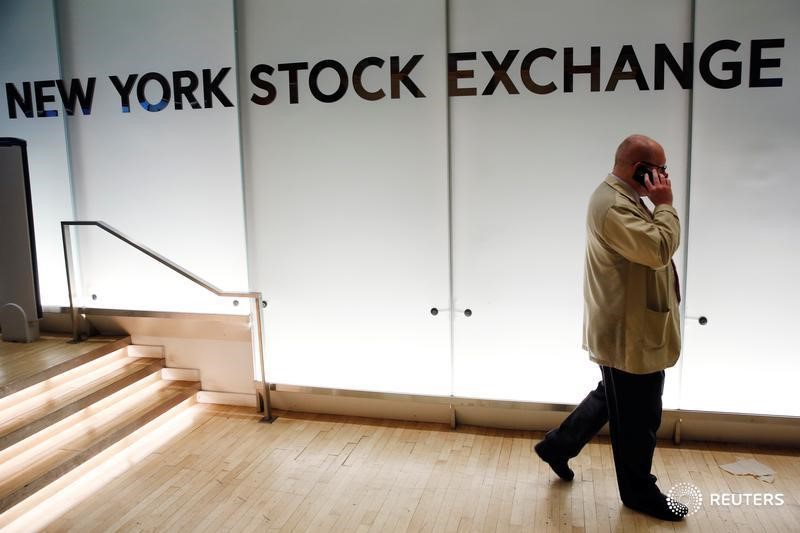Investing.com - Wall Street futures pointed to a mixed open on Monday as investors continued to speculate that increased fiscal spending and tax cuts under a Trump administration will spur economic growth and inflation and the rout in the global bond market continued, sending U.S. yields to their highest level since the beginning of the year.
The blue-chip Dow futures gained 37 points, or 0.99%, by 6:56AM ET (11:56GMT), the S&P 500 futures slipped 1 point, or 0.02%, while the tech-heavy Nasdaq 100 futures edged down 5 points, or 0.10%.
Last week, the Dow recorded its biggest weekly gain since December 2011, while the S&P 500 saw its biggest weekly gain since October 2014. The Nasdaq Composite rose 3.8%, its biggest one-week jump since February of this year.
Stocks have benefited from expectations that President-elect Donald Trump will embark on infrastructure spending and tax cuts that will stimulate the economy when he officially takes office in January.
The effects on markets have been widespread with U.S. stocks soaring, but speculation that inflation will begin to rise on the back of Trump’s new policies caused a rout in global bonds as investors require higher yields as a result.
Global bond prices tumbled on Monday, pushing yields to multi-month highs as the post-U.S. election global sell-off in sovereign debt continued, with $1 trillion on the worldwide sovereign debt having been erased already last week.
The yield on 2-year Treasury bills hit 1% for the first time since January, while that of the U.S. 10-year Treasury note was up 16.1 basis points at 2.281% by 6:58AM ET (11:58GMT).
Longer-term debt also suffered from the rout in prices and the 30-year yield gained 13.9 basis points to 3.052%.
Bond prices and yields move inversely.
Elsewhere, in European sovereign debt, yields on 10-year German Bunds were up by 7.8 basis points to 0.384%, the strongest since January, while the U.K.’s benchmark 10-year gilt yields were 10.2 basis points higher at 1.467%, surpassing the levels last held shortly before the Brexit referendum in June.
Higher inflation expectations in the U.S. translated to increased odds that the Federal Reserve (Fed) will move ahead with policy tightening as the one-month countdown began on Monday for its decision on rates on December 14.
The probability of a rate hike next month passed the 90% threshold earlier on Monday, according to Investing.com's Fed Rate Monitor Tool. Odds were last at around 86%.
Expectations for increased interest rates continued to support the dollar, which rallied to an 11-month high against a basket of major currencies on Monday.
The dollar index was recently up 0.66% at 99.64, after climbing by more than 1% to 100.03 earlier, a level not seen since December 2015.
Against the yen, the dollar was up 1.03% at 107.78, having risen to 108.16, its highest since June, while the euro was at 1.0781 after hitting the 10-month low of 1.0728 earlier in the day.
Emerging markets also continued to suffer from worries that higher interest rates could lure more investors back to the U.S. and spark an outflow of capital from their economies.
Emerging markets have been hit by fears over the prospect of a more protectionist U.S. trade stance, which would be both inflationary for the U.S. and negative for trade-exposed economies.
During his campaign Trump said he would pull America out of the Trans Pacific Partnership trade deal, build a wall on the border with Mexico and branded China a currency manipulator.
Meanwhile, the higher dollar also put further downward pressure on oil prices Monday as they continued to suffer from concerns that OPEC will be unable to deal at the cartel’s November 30 meeting that will have a meaningful impact on reducing the global supply cut.
Data late Friday showed that U.S. oil drillers continued to ramp up production. According to Baker Hughes, the number of oil rigs actively drilling in the U.S. increased by 2 in the prior week, marking its 21st increase in the last 24 weeks.
U.S. crude futures fell 1.31% to $42.84 by 7:04AM ET (12:04GMT), while Brent oil lost 0.92% to $44.34.
Elsewhere, European and U.K. stocks were broadly higher in mid-day trade, boosted by gains in the financial sector, as markets continued to digest Donald Trump’s election last week and the implications of his presidency for the U.S. economy.
Earlier, Asian shares closed mixed, with Japan’s Nikkei outperforming regional markets following stronger-than-expected economic data.
Government data in Japan showed that its third-quarter gross domestic product expanded an annualized 2.2% in the three months ended September, beating expectations of a 0.9% expansion.
